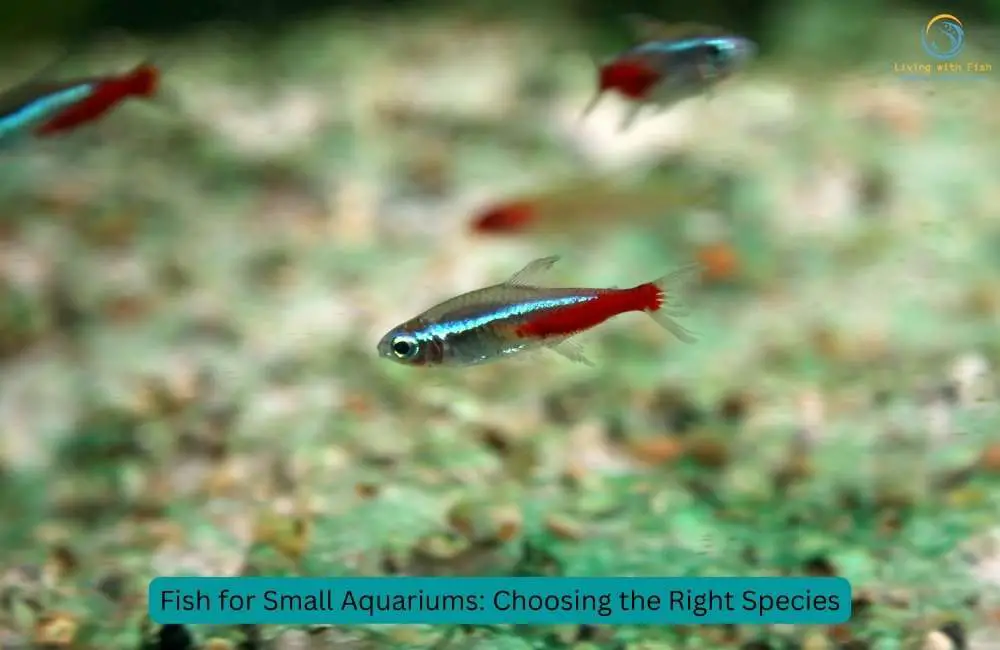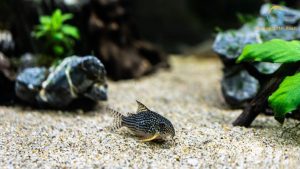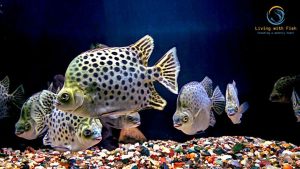This article covers the following areas –
- Why Small Tanks?
- Fish Selection: The Basics
- My Top Picks for Small Aquariums
- Small Tank, Big Responsibility
- Conclusion

Setting up a small aquarium can feel like painting on a miniature canvas. With limited space, every decision needs precision. Yet, even within this snug setting, one can create an aquatic masterpiece. Here’s my guide to selecting the perfect swimmers for small aquariums.
For small aquariums, selecting the right fish species is crucial. It involves considering the fish’s full-grown size, behavior, and compatibility with other species. Common choices include Betta fish, Neon Tetras, Guppies, Dwarf Corydoras, and various shrimp types.
A deeper dive into each species’ characteristics and care requirements is essential to make an informed decision on populating your small aquarium. Continue reading to explore detailed insights on ideal fish choices, maintenance best practices, and more.
Why Small Tanks?
Stepping into the world of aquariums can be a thrilling experience. But not everyone has the luxury of grand setups or space or time. Enter the petite charm of small tanks. With the rising popularity of nano tanks and pint-sized aquariums, one might wonder: What’s all the buzz about?
Delving a little deeper, I’ve realized that their appeal isn’t just due to their compact nature but a blend of practicality, affordability, and manageability. Let’s navigate this little aquatic realm to understand its true allure.
Space Savers
City living is all about making the most of what you’ve got. Every inch matters! As apartments shrink and spaces become cozier, the little things can make a big difference. Small aquariums fit perfectly into this narrative. Let me take you through the dual wonders of function and form these pint-sized beauties offer.
- Fitting Just Right: I’ve often marveled at how seamlessly these tiny wonders integrate into any living space. From sitting atop a study table, gracing a bedside stand, or fitting into those awkward nooks in the living room – they fit just right.
- Interior Charm: Aside from the practical aspect, these tanks also serve as dynamic decor. Watching a lively mini-aquarium can give a refreshing feel to your space, turning even the most cramped corners into vibrant focal points.
Budget-Friendly
Let’s face it – who doesn’t like saving some green? But when diving into the fish-keeping hobby, costs can pile up faster than you think, especially if you’re thinking big. This is where small tanks swoop in as the real MVPs. Allow me to walk you through the financial upside of starting small.
- Upfront Costs: My first small tank, complete with basic equipment and a few starter fish, didn’t burn a hole in my pocket. In contrast, larger aquariums can demand hefty initial investments for tanks, stands, and advanced filtration systems.
- Recurring Costs: Consider the monthly expenses – from water treatments to feed. Catering to fewer fish in a smaller volume of water is lighter on the purse strings.
Easy Maintenance
Juggling between a 9-to-5 job, binge-watching my favorite series, and trying out that new cookie recipe, I barely have time to maintain a sprawling aquatic paradise. And if your life is as hectic as mine, you’ll appreciate the blessings of low-maintenance hobbies. Let’s explore why these compact tanks are the unsung heroes for the modern busy bee.
- Quick Cleans: Cleaning my small tank usually takes up just a part of my weekend morning. There’s less water to change, fewer ornaments to scrub, and less gravel to siphon.
- Monitoring Made Simple: With fewer variables, it’s easier to notice when something’s amiss in a small tank. Be it a water discoloration, a hidden fish, or an overgrowth of algae – spotting issues becomes simpler.
Flexibility in Location
If you’re anything like me, you might occasionally be bitten by the “change-it-up” bug. Maybe it’s a sudden desire to rearrange furniture or a need for a fresh look. And trust me, relocating a 50-gallon tank on a whim? Not fun. Here’s where the nimbleness of small tanks comes to the rescue. Join me as we explore the easy-to-move, easy-to-love aspect of small aquariums.
- Moving Made Easy: Redecorating your room or shifting houses? Transporting a small tank is a breeze compared to its larger counterparts.
- Experimentation: Want to see how your tank looks under that new lamp or by the window? The compact size allows for easy relocation, allowing you to experiment with placements.
While large aquariums have their own majestic charm, small tanks bring a unique blend of convenience and charm. They’re the perfect testimonial to the age-old saying – “Good things come in small packages.” Whether you’re a seasoned fish keeper or a newbie, these little watery wonders will surely win your heart.
Fish Selection: The Basics
Navigating the dazzling aisles of an aquarium store can be both exhilarating and a tad overwhelming. Trust me, I’ve been there. Each tank gleams with a kaleidoscope of colors, fish of all shapes darting about. But here’s the deal: not every shiny fin you spot suits a small tank.
When choosing fish for compact spaces, we’ve got to be a little detective-esque, looking beyond just the immediate allure. Delve into their growth patterns, their energy levels, and how well they’d gel with potential tankmates. Let’s unpack the basics to guide you through this selection saga.
Size Matters
Remember that childhood game of fitting shapes into matching holes? Similarly, think of your small tank. It’s essential to pick fish species that won’t outgrow their space. While that baby fish at the store might fit the bill now, it’s its adult size that you should be wary of. Always research or ask the storekeeper about the full-grown size of the fish. They’ll still be free to glide, twist, and turn as they mature without feeling cramped.
Activity Levels
Not all fish are bursting with energy. Some are the equivalent of couch potatoes, while others are like marathon runners. Now, imagine squeezing that marathon runner into a small room. It doesn’t sound too fun, right? The same logic applies to fish. It’s better to opt for naturally more sedentary fish for more confined spaces. They’ll feel more at home and won’t get frustrated by the lack of long-distance swimming space.
Compatibility
Just because your aquarium is small doesn’t mean it can’t house multiple fish. The catch is they’ve got to get along. You wouldn’t want a mini underwater brawl happening in your living room. The key is to choose fish species known for their peaceful demeanor. Some species might look calm but can get a bit territorial. A quick chat with fellow aquarium enthusiasts or store experts can shed light on which fish are the congenial roommates of the underwater world.
Tank Environment:
It’s not just about the fish; it’s about their home, too. Some fish prefer tanks with plenty of hiding spots, while others might want open spaces. Plants, rocks, and other tank decorations can impact their comfort. For instance, fish that love burrowing would appreciate a fine-grained substrate. When setting up your tank, consider the natural habitat of your chosen species and try to mimic it. It’s their slice of the wild, right in your living room.
My Top Picks for Small Aquariums

Alright, so you’ve got that sparkling little aquarium sitting pretty, and now comes the exciting part—choosing the right fishy (or shrimpy) residents. From my personal forays into aquatics, I’ve compiled a list of top-notch contenders for small tanks. These guys bring flair and color to your setup and come with personalities as varied as their hues. Let’s dive into some of my favorites, and by the end, you’ll have a clearer picture of which aquatic superstar could grace your aquarium.
1. Betta Fish
Betta fish, frequently making it to the top of the list for small aquarium enthusiasts, are renowned for their radiant appearance and intriguing personality. These aquatic wonders, often bathed in hues from cobalt blues to rich crimsons, resemble elegant dancers gracefully gliding underwater with their cascading fins. It’s like watching a live painting in motion.
However, beneath that stunning exterior lies a fierce temperament. Bettas are known for their pronounced territorial instinct. This trait is especially evident in male Bettas, who won’t shy away from showing off their flare, quite literally, when confronted by what they perceive as competition. This characteristic has earned them the title ‘Siamese fighting fish.’
For those thinking about adding a Betta to their aquatic family, a key point to remember is their preference for solitude. Instead of adding other fish that might ruffle their fins, focus on creating a serene environment with plants and hiding spots. With the right setup, you’ll be rewarded with the privilege of observing a Betta’s captivating solitary dance.
2. Neon Tetras
The Neon Tetra’s name is a straight-up giveaway of its visual appeal. These diminutive fish serve as natural, vibrant illuminations in an aquarium, embodying the essence of their ‘neon’ tag. When in motion, they resemble fleeting luminescent strokes painted by nature’s own hand, a sight that can lull any observer into a trance.
While their iridescent charm is a significant draw, their amiable nature makes them an aquarium favorite. Unlike some species that might bring along the baggage of territorial disputes, Neon Tetras are the peacekeepers of the aquatic realm. They blend well with other non-aggressive fish, making them a preferred choice for community tanks.
Another fascinating aspect of Neon Tetras is their propensity to thrive in groups. The magic truly unfolds when they swim in synchrony. If you want to elevate your tank’s aesthetics, consider introducing a school of Neon Tetras. Their collective movement paints a dynamic, shimmering canvas that’s hard to look away from.
3. Guppies
Guppies are nature’s testament to the diversity and flamboyance of aquatic life. These spirited swimmers aren’t just energetic but also remarkably diverse in appearance. It’s as if each one dived a palette of patterns and colors, emerging with its unique, dazzling design.
The males, in particular, are the undeniable stars of the guppy world. Their flamboyant tails, ranging from vibrant shades to intricate patterns, make them stand out. These tails aren’t just for show; they play a vital role in their mating dances, further emphasizing their flashy nature.
But while their beauty and vivacity can be enchanting, there’s a little footnote to the guppy tale— their reproductive enthusiasm. Guppies reproduce with remarkable efficiency. So, if you’re introducing them to your tank, be prepared for potential exponential population growth.
A good strategy for those not looking to start a guppy dynasty might be to maintain a group of the same gender. This way, you get all the vibrancy without the surprise of a rapidly expanding family.
4. Dwarf Corydoras
Dwarf Corydoras, though diminutive in stature, bring significant value to any tank they inhabit. These unassuming bottom feeders, often overshadowed by their more vibrant counterparts, work tirelessly to maintain the tank’s balance.
Their prime task revolves around scavenging; they probe the tank’s substrate using their delicate barbels, searching for leftover food particles that other inhabitants might have missed. This diligent cleanup is more than just housekeeping; it helps regulate the tank’s nutrients and prevents potential issues from uneaten food.
But it’s not all work and no play for these little guys. Dwarf Corydoras, true to many fish species, are social by nature. Watch closely; they interact, forming their own little communities at the tank’s base. Their coordinated shuffling, often resembling a mini excavation squad, brings life to the otherwise overlooked bottom layer of the aquarium.
5. Shrimp
Shrimps bring a different flair to the diverse universe of small tanks. They’re an outlier, not quite fish, but equally important aquatic family members. Species like the Cherry and Ghost shrimp stand out, each with unique aesthetic appeal.
The Cherry shrimp, for instance, boasts a vivid red hue that can contrast beautifully against a backdrop of green aquatic plants. On the other hand, Ghost shrimps add a touch of mystery to the tank with their nearly see-through bodies.
But shrimps aren’t just about looks. They’re industrious creatures that contribute meaningfully to the tank’s upkeep. These diligent crustaceans often scour the tank, feasting on algae and decaying plant matter. This cleanup routine aids in controlling unwanted algae blooms and ensures a cleaner environment.
However, prospective shrimp owners should remember the importance of providing ample hiding spots. Shrimps, especially during their vulnerable molting stages, need these safe zones to retreat and rejuvenate.
6. White Cloud Mountain Minnow
With its poetic name, the White Cloud Mountain Minnow is reminiscent of serene waters and tranquil landscapes. Originating from the cool streams, these fish have evolved to be hardy, adapting efficiently to various aquatic conditions. Their slender bodies, predominantly silvery, often play with light, reflecting subtle hues of pink or green that can captivate any observer.
Being schooling fish, their true charm unfolds in numbers. Their synchronized swimming patterns create a dynamic visual play in the tank when kept in a group. Their coordinated movements and subtle color play evoke feelings of watching a harmonious aquatic ballet. White Cloud Mountain Minnows are a prime choice for those who appreciate serenity mixed with a dash of elegance.
7. African Dwarf Frogs
Whoever said you only need fish to make an aquarium exciting never met an African Dwarf Frog. Fully committed to their aquatic lifestyle, these minute amphibians bring an unexpected charm to the usual tank setup. They happily live submerged life without requiring any land section, making them suitable even for beginner aquarists.
One of their most captivating behaviors is their periodic journey to the water’s surface. Unlike fish, they need air to breathe, which results in these charming, swift dashes upwards every few minutes. As a spectator, this little ritual never gets old.
Furthermore, they possess a unique playful streak. Their endearing “froggy dance,” a sort of wiggle, often enacted during feeding time or just as a whimsical display, offers moments of sheer amusement. However, if you’re considering them, ensure your tank has a secure lid. These little jumpers might occasionally fancy a leap of adventure.
8. Endler’s Livebearer
The aquatic world’s answer to charismatic show-offs, the Endler’s Livebearer is a fish that truly believes in making its presence felt. At first glance, one might mistake them for guppies due to their striking resemblance. But a closer observation reveals the subtle differences. Being relatively smaller, their vibrant body colors adorned with intricate patterns give them a distinct identity.
Often, the real magic unfolds when they’re left to their own devices. Mostly sticking to the middle or top sections of a tank, their social dynamics come alive. A delightful spectacle is watching them flirt, chase, and play around, revealing hints of their vibrant personalities. Their swift movements and flamboyant displays can pulsate any aquarium setup with life and color.
9. Celestial Pearl Danio
A relatively new kid on the block, the Celestial Pearl Danio entered the aquarium world in 2006. But don’t let its newcomer status fool you. In a short span, this fish has managed to steal the hearts of many with its celestial beauty.
Their small size, no more than an inch, is compensated by their breathtaking appearance. The deep blue body, dotted with bright pearl-like spots and adorned with contrasting orange fins, makes them a living art piece.
Despite their celestial appeal, they’re not just for show. They have a calm demeanor and are relatively easy to care for, making them suitable for both novices and seasoned aquarists. Ideally kept in groups, when they school together, the visual display they create is akin to a mesmerizing dance of stars, bringing a slice of the cosmos into your living room.
10. Otocinclus Catfish
There’s something truly captivating about watching an Otocinclus Catfish at work. These diminutive catfish have earned a sterling reputation in the aquarium community, mainly for their diligent algae-cleaning abilities.
With their distinctive sucker mouths, they maneuver across the tank, adhering to various surfaces. From glass walls to plant leaves and decorations, they tirelessly work to rid them of unsightly algae growth. It’s almost like having a dedicated cleaning crew working around the clock.
But there’s more to these little custodians than just their cleaning capabilities. They carry a serene nature. Unlike some of their boisterous tankmates, Otocinclus prefer a more laid-back approach to life, happily coasting around and minding their own business.
They’re the epitome of non-aggression, making them an excellent choice for communal setups. However, they do appreciate some company of their own kind. So, if you plan to introduce them, consider getting a few—they’ll often be seen sticking together, grazing side by side.
11. Ember Tetra
In the aquatic world, where blues and greens often dominate, the Ember Tetra makes a bold statement with its fiery orange presence. At first glance, their color might remind you of glowing embers in a dying fire, giving them a namesake that’s spot-on.
Their small stature and intense coloration make them stand out, especially in well-planted tanks. When set against a backdrop of lush green or a contrasting dark substrate, these tiny swimmers seem to pop, creating an enchanting visual treat.
But the Ember Tetra’s appeal isn’t limited to its looks. Beyond the vibrant hue lies a gentle, sociable creature. Being schooling fish, they thrive in groups, ideally half a dozen or more.
Watching a school of Ember Tetras glides in unison, their orange bodies reflecting light is magical. They offer a serene balance to any tank—active without being too zippy and colorful without overshadowing others. All in all, they’re a delightful addition in terms of aesthetics and temperament.
Small Tank, Big Responsibility

Ain’t that the truth? Many of us (me included) initially assume that smaller tanks mean lesser responsibility. Unfortunately, it’s a misconception that can lead to some fishy mishaps. While the compact nature of small aquariums does offer certain conveniences, like taking up less space, it’s crucial to remember that the same principles of care apply, if not more.
These little aquatic worlds, teeming with life, are as dependent on our attention and love as their bigger counterparts. Like you wouldn’t neglect a bonsai tree’s care because it’s ‘just a tiny plant,’ similarly, a small aquarium demands its fair share of dedication. Let’s delve into what makes these small wonders tick and how to ensure they remain a bubbling source of joy.
#1 Regular Cleaning is Key
Contrary to what you might think, smaller tanks can sometimes get dirty faster than larger ones. This is mainly because the limited volume of water can quickly accumulate waste products. Remember that weekend when you skipped cleaning? It can have more profound effects in smaller setups. Regular water changes, cleaning of ornaments, and a light gravel siphoning are your tickets to clear water and happy fish. Keeping up with this routine can save you a lot of trouble in the long run.
#2 Keeping an Eye on Water Parameters:
It’s not just about the cleanliness; it’s about the quality. Even minor fluctuations in water temperature, pH levels, or ammonia concentrations can cause stress to your fishy friends. The smaller volume of water in compact tanks can make these fluctuations even more abrupt.
Invest in a basic water testing kit—it’s like having a health check-up tool right at your fingertips. Spotting and rectifying any imbalances early on is pivotal for a thriving aquatic environment.
#3 Avoid the Overcrowding Temptation:
I get it; there are so many captivating fish out there, and adding just one more to the mix is tempting. But overcrowding is one of the most common pitfalls for small tank owners. More fish mean more waste and less oxygen, leading to stressed and unhealthy inhabitants.
It’s not just about space; it’s about maintaining a balance. A simple rule of thumb to remember is the “one inch per gallon” rule, though it’s essential to research individual fish needs, as some might require more space than others.
#4 Equipment Matters:
It might be a small tank, but the equipment you choose can make a world of difference. From heaters to filters, ensure you pick devices suitable for your tank’s size. For instance, an overly powerful filter can create strong currents, stressing out your fish. Conversely, an inadequate heater might not provide the consistent warmth your aquatic pals need. Research and select wisely.
#5 Plants and Decor:
Just like we love sprucing up our homes, the right decor can enhance the aesthetics and functionality of your small tank. Opt for plants and ornaments suitable for compact spaces. They add a visual appeal; plants, in particular, can aid in oxygen production and provide your fish with natural hideouts. However, remember not to overdo it; you want your fish to have ample swimming space.
There you have it, a crash course in small tank care. With a sprinkle of dedication, a dash of love, and a bit of regular upkeep, your pint-sized aquatic wonder can flourish, becoming a serene oasis for its inhabitants and you.
Conclusion
Selecting the right species for a small aquarium is both an art and a science. With myriad choices available, it’s essential to prioritize the well-being of the aquatic residents. This entails understanding their growth potential, behavior, and cohabitation needs.
While smaller tanks come with certain conveniences, they are not exempt from the responsibilities of fish care. With regular maintenance, monitoring, and a commitment to avoiding overcrowding, your compact aquatic haven can flourish, serving as a mesmerizing mini-ecosystem and a testament to your dedication.
Whether you’re a newbie or a seasoned aquarist, the joy of seeing a well-maintained tank thrive is unparalleled.






